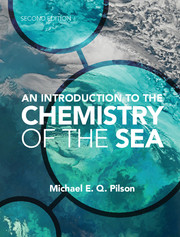Book contents
- Frontmatter
- Contents
- Preface
- Acknowledgments
- 1 Introduction
- 2 The water in seawater
- 3 Salinity, chlorinity, conductivity, and density
- 4 Major constituents of seawater
- 5 Simple gases
- 6 Salts in solution
- 7 Carbon dioxide
- 8 Nutrients
- 9 Trace metals and other minor elements
- 10 Radioactive clocks
- 11 Organic matter in the sea
- 12 Anoxic marine environments
- 13 Exchanges at the boundaries
- 14 Chemical extraction of useful substances from the sea
- 15 Geochemical history of the oceans
- Appendix A The chemical elements
- Appendix B Symbols, units, and nomenclature
- Appendix C Physical properties of seawater
- Appendix D Gases
- Appendix E Carbon dioxide
- Appendix F Dissociation constants and pH scales
- Appendix G Solubility of calcium carbonate
- Appendix H Effects of pressure
- Appendix I Radioactive decay
- Appendix J Geochemical reservoirs, and some rates
- Appendix K Sound absorption
- Epilogue
- Questions for chapters
- Glossary
- References
- Index
- Miscellaneous end matter
- References
13 - Exchanges at the boundaries
Published online by Cambridge University Press: 05 February 2013
- Frontmatter
- Contents
- Preface
- Acknowledgments
- 1 Introduction
- 2 The water in seawater
- 3 Salinity, chlorinity, conductivity, and density
- 4 Major constituents of seawater
- 5 Simple gases
- 6 Salts in solution
- 7 Carbon dioxide
- 8 Nutrients
- 9 Trace metals and other minor elements
- 10 Radioactive clocks
- 11 Organic matter in the sea
- 12 Anoxic marine environments
- 13 Exchanges at the boundaries
- 14 Chemical extraction of useful substances from the sea
- 15 Geochemical history of the oceans
- Appendix A The chemical elements
- Appendix B Symbols, units, and nomenclature
- Appendix C Physical properties of seawater
- Appendix D Gases
- Appendix E Carbon dioxide
- Appendix F Dissociation constants and pH scales
- Appendix G Solubility of calcium carbonate
- Appendix H Effects of pressure
- Appendix I Radioactive decay
- Appendix J Geochemical reservoirs, and some rates
- Appendix K Sound absorption
- Epilogue
- Questions for chapters
- Glossary
- References
- Index
- Miscellaneous end matter
- References
Summary
. . . the ocean may receive supplies of salt from rocks and springs latent in its own bosom, and unseen even by philosophers.
Robert Boyle 1673Our understanding of the processes that affect or control the chemistry of the sea began with the obvious fact that rivers run into the sea, and they carry the washings of the land into the sea. Then came some appreciation of the evaporation of water and the rudiments of the major hydrological cycle. In the twentieth century it become generally appreciated that atmospheric dust is a major contributor to oceanic sediments, and in the latter decades of that century the transport of many sub- stances through the air between land and sea became generally appreciated. In the last half of the century it also became generally well known that throughout the floor of the ocean there is some likelihood of significant chemical exchanges between the sediment and the overlying water, and between seawater and the hot rocks at the spreading centers and other volcanic regions on the sea floor, and that these have important influences on the chemistry of the ocean. None of the fluxes involved is really well known for any substance, however, although the estimates for river inputs of most substances are certainly satisfactory for geochemical calculation, and most of the other fluxes are well enough constrained for first-order estimates and calculations. Much less is known about the factors that might cause changes in the rates of many of the important fluxes.
Deep as it is, the ocean is still a thin layer on the surface of Earth, and during the course of several thousand years nearly every drop of water has some opportunity to be exposed to the air–water boundary at the surface and to the sediments and rocks at the bottom. The chemical exchanges that influence the sea occur at all these boundaries, and in turn the sea profoundly affects the air above and the sediments and rocks below. In the sections that follow, these exchanges are examined further.
- Type
- Chapter
- Information
- An Introduction to the Chemistry of the Sea , pp. 342 - 367Publisher: Cambridge University PressPrint publication year: 2012



